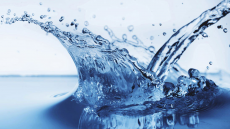

Water cycling
What is infiltration?
This is the permeation of a liquid into something by filtration. Water from rain or snow may end up in a shallow layer of soil and it will then gradually move vertically and horizontally through the soil and subsurface material. Eventually, it may enter a stream by seeping into a stream bank.
Ground water storage is the storage of large amounts of water. It becomes an aquifer when there are enough water-bearing formations capable of yielding enough water to supply to a population. In this case, water moves slowly in the direction of lower lying places. The water is either discharged from aquifer springs, seeped into streams or is withdrawn from the ground by wells. In the United States, approximately 40% of the public water supply comes from groundwater in principle aquifers.
In ground water storage, there are layers: unsaturated zone, saturated zone and the water table. The unsaturated zone is part of the subsurface where water is present in varying amounts but do not saturate soil. The water table is found below, this is where ground water occurs. The saturated zone is where pores, cracks and spaces between rock particles are saturated with water.
Regulation of water quality and quantity
Water is regulated through physical processes and ecosystems. Reminder that ecosystems are the biological communities of interacting organisms and their physical environment. When regulating we must balance the needs of society with caring for the environment. The supply of water is affected by climate change, land use and rate of extraction and use.
The Millennium ecosystem assessment says that 5 to possibly 25% of global freshwater use exceeds long-term accessible supplies. Additionally, 15-35% of irrigation withdrawals exceed supply rates. This is unsustainable. The capacity of ecosystems to buffer from extreme events has been reduced through loss of wetlands, forests, mangroves. It is therefore our responsible to find solutions to reach a compromise. Globally water quality is declining. Agriculture, and cultivated systems have had negative impacts on freshwater. For example, pollutant use has led to eutrophication. Eutrophication is the excessive nutrient presence leading to mass plant growth, leading to a disruption in biodiversity.
Flood damage is a highly expensive problem which we have to tackle. It costs approximately £1.1 billion per year in the UK, where 1 in 6 are at risk of being affected. LEDC stands for less economically developed countries. You can probably guess what MEDC stands for. cLEDCs are often more affected by MEDCs as LEDCs have less resources to prevent flooding or to clean up the mess after a flooding. Solutions to flooding vary, but there are useful ways to mitigate flooding impacts. Providing vegetative cover means that minerals from soil can be trapped while plants take up nutrients. Trees and plants intercept precipitation, thus a reduction in surface run-off. Not only does managing drainage reduce flooding, it also removes pollutants. Ponds are a natural method of draining. Additionally, we can maintain rivers. Furthermore, installing infiltration devices will enhance the capacity of ground to store and drain water. Dry basins promote infiltration of surface water to ground. Injection wells can artificially recharge water.
Image - https://www.ypo.co.uk/news-and-events/news/improving-efficiencies-for-public-sector-water-supply

0 Comment:
Be the first one to comment on this article.